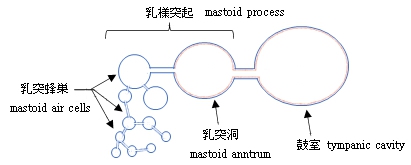
・「乳様突起の上前方では、乳突蜂巣は大きく不規則で含気しているが、下に進むにつれて小さくなり、乳様突起の
尖端部では多くの場合ほんの小さなものになり、骨髄もある。」(ウィキペディア)
・「突蜂巣は鼓室洞の憩室だと考えられており、出生後に現れて5歳までにはかなりはっきりしてくる。乳突蜂巣の発達は
思春期まで続く。」(ウィキペディア)
・空洞の大きさや数には非常に差異が見られ、場合によっては空洞が全く見られず完全に骨になっていることもある。



以下は「Wikipedia」の解説文となる。
The mastoid cells (also called air cells of Lenoir or mastoid cells of Lenoir) are air-filled cavities within the mastoid process of the temporal bone of the cranium. The mastoid cells are a form of skeletal pneumaticity. Infection in these cells is called mastoiditis. The term "cells" refers to enclosed spaces, not cells as living, biological units.
【Anatomy】
A section of the mastoid process will show it to be hollowed out into a number of spaces which exhibit great variety in their size and number. At the upper and front part of the process they are large and irregular and contain air, but toward the lower part they diminish in size, while those at the apex of the process are frequently quite small and contain marrow. Occasionally they are entirely absent and the mastoid is solid throughout.
【Development】
At birth, the mastoid is not pneumatized, but becomes aerated before age six.
【Function】
The air cells are hypothesised to protect the temporal bone and the inner and middle ear against trauma and to regulate air pressure.
【 語 句 】
・mastoid process:茎状突起 ・temporal bone:側頭骨 ・cranium:頭蓋 ・pneumaticity:含気腔? ・mastoiditis:乳様突起炎 ・hollow out:えぐって穴を開ける ・pneumatized:含気[の] be hypothesisde to~:~するためと考えらている? ・trauma:外傷 ・regulate:調節する
■ 写真やイラストを掲載しているサイト ■
・ イラストや写真を掲載しているサイト-Ⅰ
・ イラストや写真を掲載しているサイト-Ⅱ
・ イラストや写真を掲載しているサイト-Ⅲ
・ イラストや写真を掲載しているサイト-Ⅳ
・ イラストや写真を掲載しているサイト-Ⅴ
